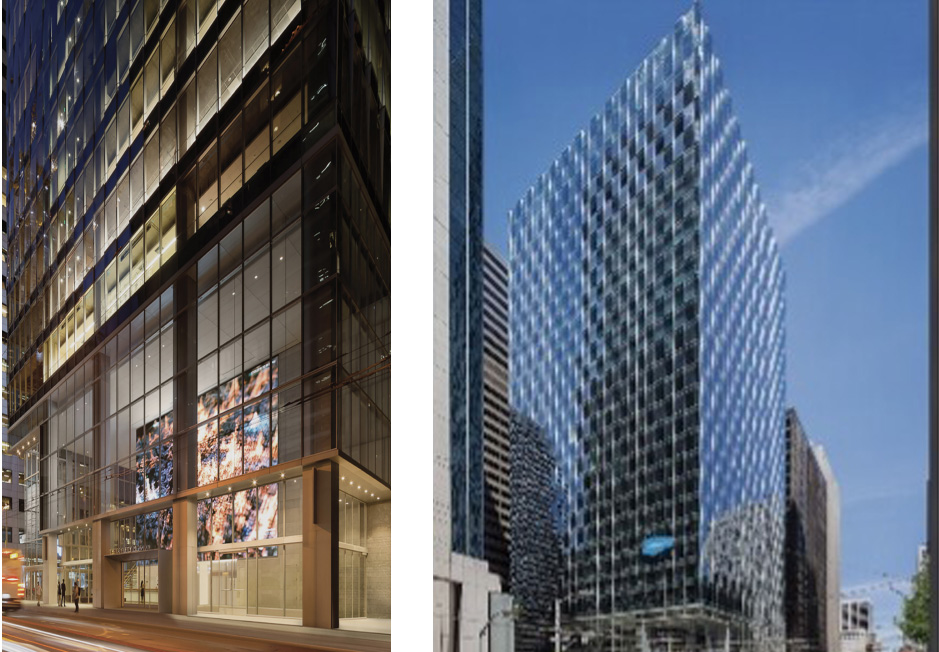Water is needed in commercial buildings for a variety of reasons. People require it for drinking while some is also needed for sanitation. Building systems require additional water, particularly for hydronic heating and cooling systems or for landscape irrigation. As long as water is properly contained and channeled in all of these systems, then it can be used efficiently consistent with water conservation standards. However, if a leak or some other malfunction occurs, then water is wasted or can cause damage. This is a particular concern in green building design where the use of water is intended to be monitored and controlled. In fact, the LEED Rating System from the U.S. Green Building Council recognizes water efficiency as one of the primary categories of effective green building design. Based on all the foregoing, this course looks at the issue of water leaks and the related water waste and potential damage concerns. It also reviews some of the traditional means to safeguard against water leakage by using several types of detection systems. The latest technology of using a wireless leak detection system is explored and compared to other systems to help design professionals make decisions on specifying the most appropriate and sustainable system for commercial buildings.
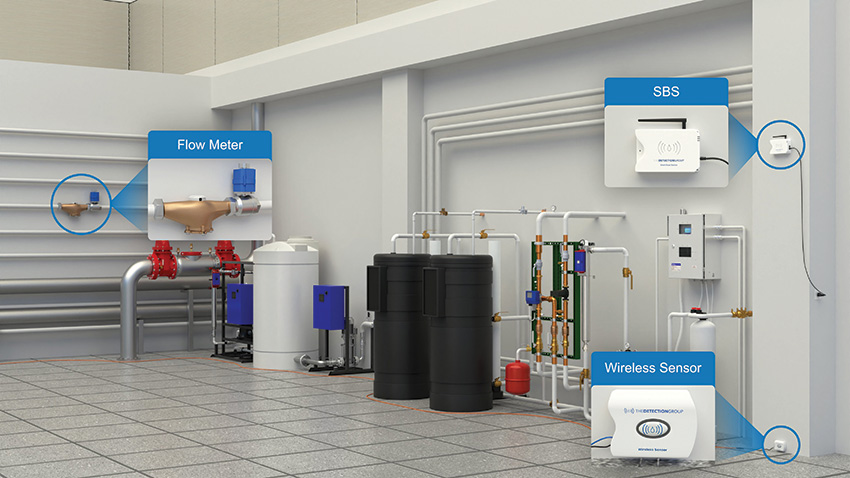
Photo courtesy of WATTS Water Technologies
The efficient use of water in buildings is a premise of any sustainable building. Monitoring water use and controlling for any potential leakage is key to long-term performance.
THE ISSUE: EXCESSIVE USE OF WATER
Water is increasingly recognized as a precious commodity, with scarcity of supply a growing concern in many regions. Since it is a necessity for life and needed for many building operations, it is appropriate to look more closely at where that water is being used. According to the U.S. Environmental Protection Agency (EPA), water is typically consumed for the following multiple purposes in commercial buildings:
- Restrooms/drinking–an average of 37 percent of total use
- Cooling and heating–an average of 28 percent of total use
- Landscape watering–an average of 22 percent of total use
- Kitchen / dishwashing–an average of 13 percent of total use
All these water uses need systems that provide water in a manner that is efficient, meaning they only use the appropriate amount of water when and where it is needed. Systems that waste water by using too much for the intended purpose are less sustainable and can end up being costly over time. Some of the approaches to prevent excessive water use include:
- Conservation efforts that use intentional design efforts to reduce or eliminate water usage.
- Specifying equipment and systems that use water as efficiently as possible within those systems.
- Setting up a means to monitor ongoing water usage within a building or facility.
- Incorporating a system to detect and respond to water leaks, unusual water consumption, or excessive water flow.
Any of these strategies can be applied to any of the water usage categories described by EPA.
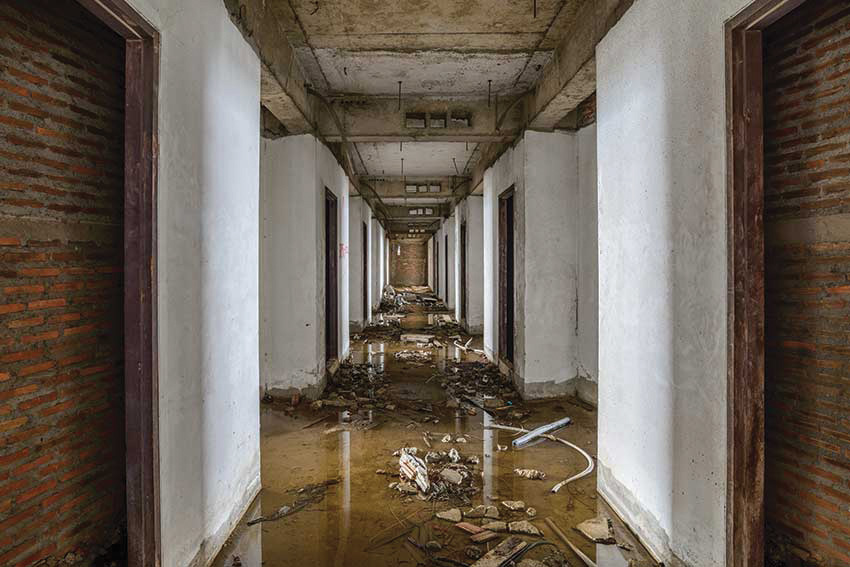
Photo courtesy of WATTS Water Technologies
An undetected water leak not only destroys water efficiency, it can cause considerable damage to a building, interrupt building operations, and create potentially unsafe indoor environments for occupants.
Leaking Water
According to the insurance industry, water damage is the number one cause of property loss claims in commercial buildings by a significant margin. On average, 57 percent of all real estate insurance claims made are for water damage, leaving only 43 percent for everything else. The bigger picture reality is that water leaks happen all the time and in almost every building. That means that even the most efficient designs for water systems can be severely compromised if a leak develops while the building is operating, and the chances are high that it will.
The significance of water leaks should not be underestimated, since several unintended outcomes come about:
- Water efficiency and conservation is completely undermined if a plumbing system develops undetected water leaks that go on over time.
- Water leaks can cause severe damage not only to building finishes, systems, and even the structure, but also to building contents as well such as machinery, equipment, furniture, records, computers, etc.
- People can be directly impacted not just by getting wet, but water leaks cause mold to grow, which can directly impact human health and indoor environmental quality.
Not only do building owners need to be aware of the potential for water leaks, but so do design professionals as part of their firm’s risk management strategy. That is because the longer it takes to discover a leak, the higher the costs can be and the higher potential for liability. The longer water leaks out, the bigger the cleanup will be, business or other operations may be disrupted, and the health of building users or tenants may suffer. And as noted, excessive water leakage is clearly not sustainable, undoing any efforts during design in that regard.
While any building could suffer from water leaks, some circumstances can carry increased risk:
- Newly constructed buildings, which need to go through a start-up and commissioning period to find and detect any plumbing issues.
- Aging buildings (i.e., more than 20 years old) may have plumbing parts or components that are wearing out.
- Buildings with raised floors which can conceal inconsistencies in the plumbing.
- Buildings that experience extreme seasonal weather, causing expansion and contraction of the piping system.
- Medical related buildings with extensive plumbing/piping systems located near sensitive and expensive equipment or near the storage of irreplaceable medical samples.
- Multi-floor buildings with tenants above and below each other with multiple sources of water on each floor.
Design professionals engaged in any of these higher risk types of buildings should certainly pay careful attention to the potential for water leakage from the plumbing and drainage systems and the means to address it.
LEED AND WATER EFFICIENCY (WE)
The LEED Green Building Rating System developed by the U.S. Green Building Council is the most recognized voluntary standard for determining the sustainability of a building. Among its various versions and building types, water efficiency has always been a prominent category. LEED version 4 is the current standard with LEED 4.1 available as a Beta pilot. Depending on the building type, 11 or 12 points are available for water efficiency out of a total possible point total of 110–a full 10 percent of the possible point total. To achieve these points, there are three prerequisite requirements and four credit opportunities.
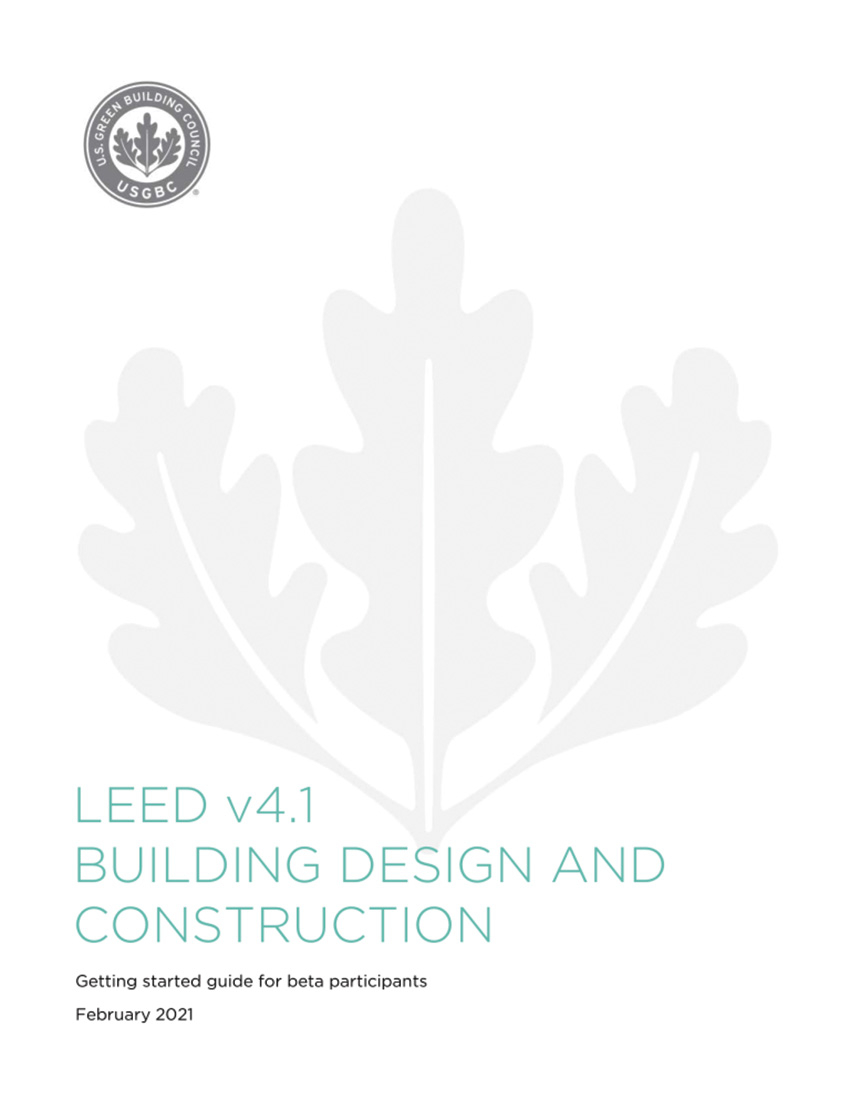
Photo courtesy of USGBC
LEED version 4.1 maintains the same water efficiency criteria as previous versions with clarifications for different building types.
Water Efficiency (WE) Prerequisites
Prerequisites in LEED are used to set minimum baselines for performance. In the case of water efficiency, three areas are addressed.
- Outdoor Water Use Reduction LEED recognizes that water is often used on building exteriors for things like irrigation of planted materials or lawns. The stated intent of this prerequisite is “to reduce outdoor potable water consumption and preserve no and low-cost potable water resources.” The requirements are to show a basic effort to either eliminate any need for irrigation or to reduce the amount of irrigation needed by at least 30 percent compared to a calculated baseline for the site’s peak watering month. Tactics include selection of plants that need less water and irrigation system efficiency.
- Indoor Water Use Reduction The intent of this prerequisite is to similarly reduce water consumption, but inside the building in this case, and preserve potable water resources. At a minimum, aggregate water consumption must be reduced by 20 percent compared to baseline requirements. Further, all newly installed plumbing fixtures need to be labeled under the EPA “Water Sense” program or a similar applicable program for efficiency.
- Building-Level Water Metering It may be surprising for some to learn that certain areas of the country don’t use or require water meters to be installed in a building. Utility based water usage charges are calculated in a different manner. LEED therefore requires in this prerequisite that a building level water meter is installed to provide the bulk total water usage of the building and related grounds. Further, if the building becomes LEED certified, then the owner agrees to provide the bulk water usage data (monthly and annual) for a five-year period from certification or occupancy.
Once these three prerequisites are satisfied, then earning points through water efficiency credits becomes possible.
Water Efficiency (WE) Credit Opportunities
There are four possible credit categories here–three extend the prerequisite levels of efficiency and one addresses process water use.
- Outdoor Water Use Reduction In order to earn points in this credit, there are similarly two options as in the prerequisite. First, if it can be demonstrated that the landscape does not require a permanent irrigation system beyond a maximum two-year establishment period, then 1-3 points are possible depending on building type. Second, if an irrigation system is used, but it can be demonstrated that the landscape water requirement (LWR) is reduced by at least 50 percent (i.e., more than the minimum prerequisite requirement of 30 percent), then 1 point can be earned. If reductions of 75 or 100 percent are shown, then additional points can be earned up to 3 total.
- Indoor Water Use Reduction In order to earn this credit, additional fixture and fitting water-use reductions compared to the baseline calculation must be demonstrated beyond the 20 percent prerequisite. Essentially, one point is awarded for every additional 5 percent reduction above 20 percent; up to 5 or 6 points for buildings that achieve up to 45 or 50 percent water use reduction. Exemplary performance (potentially eligible for an innovation credit) requires at least a 55 percent reduction. Some building types require some additional equipment documentation for efficiency.
- Optimize Process Water Use The intent behind this credit is to conserve water used for mechanical processes while also controlling corrosion and scale. There are three options to demonstrate performance for this credit, all of which rely on sustainability focused engineering design. The first option is for cooling towers and evaporative condensers based on a one-time potable water analysis in the system compared to five control parameters. In addition, controlling the number of cooling tower cycles and/or using recycled water in the system needs to be addressed. The second option is based on optimizing water use for cooling by comparing actual water use reduction to an engineered baseline. The third option allows the use of recycled alternative water to meet 20 or 30 percent of the water demand for the system. For any of the options selected, 1, 2, or 3 points can be earned depending on the degree of performance and the building type.
- Sub-System Water Metering LEED recognizes that it is difficult to measure your water use, let alone conserve it, if you cannot track it in real time. Relying on the municipal water meter to track water usage is not enough, because it’s a bulk building measure and usually only offers historical data. Therefore, this credit is available for any building design that includes permanent water meters for at least 80 percent of two or more water subsystems as may be applicable to a project. That includes irrigation, indoor plumbing fixtures and fittings, domestic water heaters, boilers, reclaimed water, and other process water. Particularly important for LEED Operations and Management (O+M), it is pointed out that, “Submetering water subsystems helps facility managers track changes in water usage over time and provides the data necessary to identify opportunities for water savings by end use, which may help improve a project’s water performance score. Submetering is a vital component of a successful water management program; metered data enables monitoring of consumption and costs as well as progress reporting throughout the building life cycle.”
Clearly, there is a multifaceted approach in LEED to help achieve water efficiency in buildings and conserve natural water resources.
WATER MONITORING AND METERING SOLUTIONS
To address water efficiency and sustainability goals, determining a baseline water use for a building and its subsystems is the first step. That data can identify the normal or sustainable levels of water usage over time. Reducing water usage by detecting leaks and shutting off unusual flow helps to assure that water is not inadvertently wasted or that other associated problems arise. If a water leak does occur in a building, then someone needs to know about it quickly so that the water flow can be stopped and the problem repaired. There are several common approaches to address this as discussed in the following sections.
Stand-Alone Water Sensors
Simple visual or auditory observation by users or maintenance staff in commercial buildings is the most basic, but obviously the most unreliable, method of detecting a water leak. That is because leaks can happen even when the building is not occupied or when maintenance staff are off duty. Even if the building is occupied, people may not be near the location where the leak occurs (e.g., mechanical rooms, etc.) If the leak is seen, then some people may not recognize it as a problem, assuming that it is a normal maintenance or cleaning activity.
A better method over simple observation is to have a device available that triggers an audible alarm if a leak occurs, much like a smoke alarm alerts people to that hazard. Water alarms, sometimes called “screamers,” are inexpensive point sensors that are placed on the floor–if they detect water, then they sound an alarm or “scream.” These alarms use 1980s technology and are stand-alone devices, i.e., they are not connected either to each other or to any other monitoring system. They obviously are only effective if someone is within earshot to hear it, understands what it is for, and can act on it. Hence, these qualities make them suitable for single-family residential use but not as well-suited for commercial use.
More up-to-date water leak sensors are electronic and attach wirelessly to a larger leak monitoring system. In that situation, they are well suited to commercial building systems that incorporate a total, coordinated, wireless solution. However, it is important to recognize that not all leak detection and notification systems are the same. For example, if the system only sends a text or email, the recipient may overlook that notification, especially if it occurs at night. Systems that also initiate alarms and telephone calls are obviously more likely to actually alert a person who can respond.

Photo courtesy of WATTS Water Technologies
There are distinct types of flow meters which can either be invasive or noninvasive to the existing plumbing system.
Sensing Cables
Another common commercial building solution is to use a sensing cable that can sense water at any point along the wire or an attached sensor. This approach normally requires electrical power to each wire or sensor, so that needs to be planned and designed accordingly. While the cables can cover a large area, if there is limited power, then additional electrical wiring is needed which can be costly. Therefore, they are mostly used in computer server rooms and data centers where lots of power and wiring are already available and there is a need for extensive water leak detection. Sensing cables can also be good for placement in tight, hard-to-reach areas, although once installed, they may be difficult to maintain and access. They can be attached to a stand-alone alarm or integrated as part of a larger, wireless leak detection system.
Flow Metering
Another choice to detect a potential leak uses a sensor on supply water piping to monitor the flow in the amount of supply water. The sensor is tracking for any unexpected increase in the amount of water flowing over time through the piping–a possible sign of a leak in the line somewhere. The goal is to sense water that is coming out of the pipe, not just flowing through the pipe. However, since it is only measuring water flow in a piping system, it does not locate where the leak is occurring.
There are three types of flow sensing, also called flow metering. The first type is wrapped around an existing utility meter and reads inflow to the building. This is a noninvasive approach that keeps the existing plumbing intact. The second type is wrapped around, or ‘clamped-on’ a pipe, instead of the meter and is similarly noninvasive. The third type is installed as a submeter and interrupts the pipe for the meter installation.
In terms of effectiveness, all three of these flow meter types can detect a leak significant enough to increase the water flow in a building or a subsystem. However, if there is only a slow drip, that would not be readily detected by most meters unless it can discern small changes in flow. In a typical 1.5-inch-diameter pipe, for example, the flow meter needs to be extremely sensitive to discern between 10 gallons per minute (gpm) and a potentially damaging 10.05 gpm. The best ones to specify to perform to an elevated level are “smart and wirelessly connected” as part of an overall leak detection system and not just a stand-alone piece of plumbing.
WIRELESS WATER LEAK DETECTION SYSTEMS
The most up-to-date option for leak detection and water efficiency control is a wireless, sensor-based system that connects individual sensors and flow meters to a central communication hub.
Wireless systems can be installed and operate anywhere that a wired system can installed but for significantly less cost since there is no wiring needed. It can also be installed in many places where wired systems are not practical. These systems use cloud-based IoT (Internet of Things) technology often combined with radio frequency (RF) network systems in the building. Just like a smoke or fire detection system, these wireless systems act automatically to sense water leaks and notify building personnel by phone call, text, and email of the precise leak location. An internet cloud platform is available that provides remote monitoring anywhere in a building 24/7 and informs building staff when and where leaks are occurring before they become a flood. If needed, electronically controlled shutoff valves can also be added to the design to shut off water flow automatically. Valves can be programmed to close upon the alarm from one or many sensors in a given area or floor.
Factory Mutual (FM) is one of the largest global commercial insurance carriers known for providing clients with engineering solutions to reduce risk. They operate an Approvals Certification program for manufacturers to have their products independently tested for use in buildings. FM Standard 7745, “Approval Standard for Liquid Leak Detectors,” establishes the benchmarks for best-in-class certification for water leak detection equipment. When specifying or incorporating a wireless leak detection system, the label “FM Approved” indicates that a system meets the stringent FM standard 7745 and receives the certification mark.
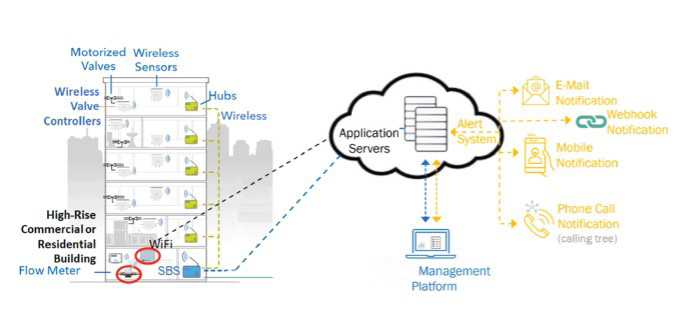
Photo courtesy of WATTS Water Technologies
A complete water leak detection system includes sensors, flow meters, and valve controllers all tied to a central hub or platform that can alert appropriate personnel if water use is irregular.
How It Works
A wireless leak detection system fundamentally involves battery powered leak detection sensors located throughout the building that are connected wirelessly to distributed hubs (typically every 1-2 floors). The hubs are then connected to a central building base station. Communication inside the building is routed through radio frequency (RF), not wi-fi, because communication ranges are often required in the hundreds of feet. RF is in the sub-1000 MHz─the lower the frequency, the longer the effective distance.
The RF backbone of the system includes the strategically located base station, which communicates via RF to the required number of hubs located as needed throughout the building. The hubs in turn communicate wirelessly to potentially hundreds of endpoints located throughout their area of coverage. These endpoints can be sensors, electronic valve controllers, and, most recently, flow meters.
The base station itself is plug powered and is the only piece of equipment connected to the internet via ethernet wiring or a cellular data connection. If preferred, the base station can connect to the cloud via cell modem or wi-fi. This connection allows facility management personnel to communicate remotely with the system to monitor its performance or receive alerts.
WHEN TO USE WIRELESS WATER FLOW SYSTEMS
Generally speaking, there are three broad applications for incorporating a wireless leak detection system that includes flow meters and other components, discussed as follows.
Water Conservation and Sustainable Design
Whether a building is being considered for LEED or not, virtually every building owner does not want to waste money on excessive water use any more than on excess energy use. Further, they don’t want to have the longevity of their facility compromised by potential water damage or unhealthy conditions. Hence, water efficient sustainability is simply part of good design and consistent with building owner expectations.
A wireless, sub-metered, water flow system addresses all these needs by being able to first monitor the full building water usage but also track any separate tenant or user groups’ water usage. This provides information to determine which areas of the building are using the most water and compare that usage to baseline levels for similar users. The ability to track real-time usage and history of usage makes it possible to pinpoint specific patterns of use and seek out ways to improve water efficiency. The system can also identify irregular or excessive flow or potential stagnation in water subsystems, such as irrigation or others. All of these aspects of the system help minimize unnecessary water usage, improve overall water-use efficiency, and directly help the building or facility become more sustainable.
Existing and Newly Constructed Buildings
All types, sizes, and uses of buildings can directly benefit from appropriately sized and designed water flow metering systems. Smaller buildings, such as bank branches, retail stores, etc., can benefit from a simple system using wireless “smart” flow meters with notification capabilities. Facilities without 24/7 property management teams or full-time engineers can use such a simple system to protect from costly water leaks and damage during off hours. If flow is abnormally high or remains high for a longer period than normal because of a leak in the system (or water running when it should not be), the flow meter will notify the designated personnel. If automatic valves and controllers are included as part of the system, then they can then shut the water supply off without the need for anyone to come and do that manually. That quick reaction is like having a full-time engineer right there on property, saving small-building owners from expensive water damage losses, higher insurance deductibles, and even the possibility of policy cancellation.
Larger buildings also benefit from adding a flow meter-based system for the entire building or for specific areas. During construction, worksites are prone to water leaks, especially when crews are not on site. Protection from costly work stoppages and schedule delays can be incorporated simply by monitoring water usage beginning with the construction period. If flow is abnormally high or remains high for a specified period of time, a smart flow meter can notify the construction manager or supervisor of the unusual flow. An automatic valve and controller can also shut the water supply off until it can be further investigated. Once the building is occupied, the water flow and leak detection system can be used to monitor efficiency, detect leaks before they become catastrophic, automatically control valve closures based on flow or temperature, and allow for manual valve closures after an alert is triggered.
Cooling Towers or Closed Loop Hydronic Systems
Closed loop heating and cooling water systems typically require very little makeup water. Therefore, if an unusual amount of makeup water is being called for, it can mean a small leak has occurred somewhere, which can result in considerable damage if it goes undetected. A flow meter on the makeup water line provides early notification of a leak somewhere in the system, thus allowing the avoidance of a potential disaster. This is particularly true for closed-loop hydronic systems and cooling towers, especially on larger buildings or facilities. Flow meters can be appropriately selected for smaller pipe sizes up to 2-inch diameter or for larger pipe sizes up to 8-inch diameter. The same user configurable data collection and alerts and automatic shut off features can be implemented for these systems as for buildings in general. That means the amount of water in these systems can be readily monitored and compared over time or between different systems. In particular, the cooling tower cycles of makeup and blowdown water can be tracked for consistency or any potential problems. It also means alerts can be sent before the water is shut off if an issue arises.
In all these applications, the key components are flow meters that are “smart” connected so they can give notifications and be near a valve which can be controlled remotely. They can be an add-on to an existing monitoring system or be part of a new system. They can tie-in to irrigation system and help be more sustainable, so the irrigation need is reduced and operation occurs only when absolutely needed. The full system can track how much water is going where on a real-time basis. All of these improve water efficiency, help avoid damaging leaks, and save the building owner from potential losses.
WHAT HAPPENS WHEN A LEAK OCCURS?
When any of the endpoints in a wireless system (i.e., sensors, flow meters, etc.) detect a leak or abnormality, an audible alarm is set off. At the same time, a wireless message is sent from the sensor to its closest hub, down the building to the base station, and out to the cloud. Three types of messaging then happen simultaneously to communicate the message that a leak is detected:
Phone A phone call is made, typically to the security desk, although the building owner or manager ultimately decides who receives the calls.
Email E-mail messages are sent to preselected personnel.
Text SMS text messages are sent to preselected personnel.
This immediate notification system, relayed to multiple people in multiple ways, helps to ensure that a leak can be responded to promptly.
It is worth noting that in addition to an alarm indicating that a leak has been detected, the system can also send alerts which are informational messages. Examples of alerts include a low battery in one of the endpoints or a loss of communication with a device for some reason.
If there is any concern about false alarms, it is good to know that they can be controlled. In many commercial buildings, a significant concern can be the ability to easily silence a sensor that is accidentally set off. For example, if the sensor is on the floor of a kitchen or restroom, janitorial staff can unintentionally cause the alarm to go off by hitting it with a mop or spreading cleaning water on the floor. In cases like this, having a delay is important, but the event should be recorded for tracking purposes. If it happens too often, the sensor should be moved to a different location. The delay period on the sensors should be configurable, because while a 15-second delay may be appropriate for sensors in the restroom, no delay should be used for sensors in an electrical room or other critical areas.
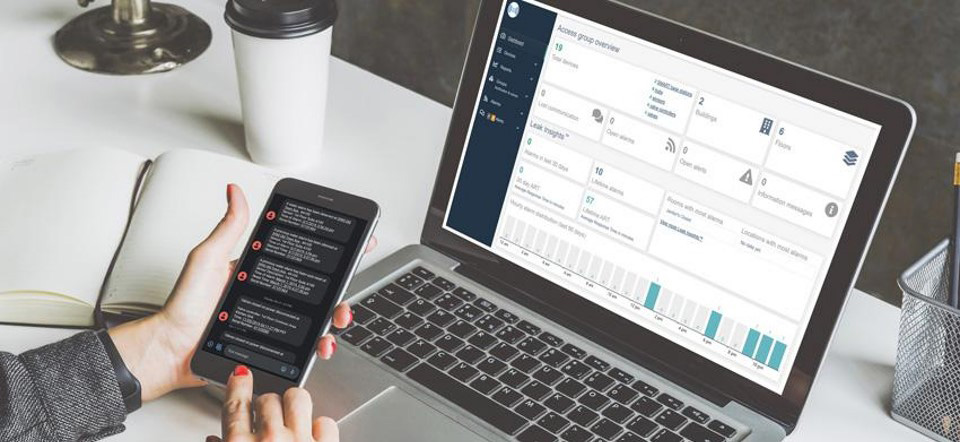
Photo courtesy of WATTS Water Technologies
Wireless messages are used to communicate an alarm condition in a complete water leak detection system.
Data Reporting
For each type of notification generated by the system, data is recorded and can be made immediately available. In particular, the precise time and location of a leak is reported, so the first person on the scene knows exactly where to go to turn off the alarm, resolve the issue, and reset the sensor. The system then keeps the data of when the leak happened, who received notifications, and how long it took someone to get there. Knowing this response time and sequence of events is an important feature for many businesses. All this data from water leak events, alarms, and alerts can be stored, formatted, and used for reporting purposes. Overall, this helps create an information resource to contribute to better building management and to track the return on investment of the system.
CONCLUSION
The problem and issues associated with water leaks and inefficient water use in buildings are quite real. Several different approaches are used to improve water efficiency in buildings of all types, including water use reduction in exterior and interior locations, mechanical system water control, and submetering of water flows. The most up-to-date, dependable, and cost-effective solution is a wireless water leak detection system. Design professionals who incorporate such systems into new or existing commercial buildings can help overcome wasting water and save building owners and managers from considerable losses. At the same time, the sustainability of the building is improved during its operating life while the health and safety of building occupants is improved.
Peter J. Arsenault, FAIA, NCARB, LEED AP is a nationally known architect and a prolific author advancing positive acoustical experiences through better building design. www.pjaarch.com, www.linkedin.com/in/pjaarch







